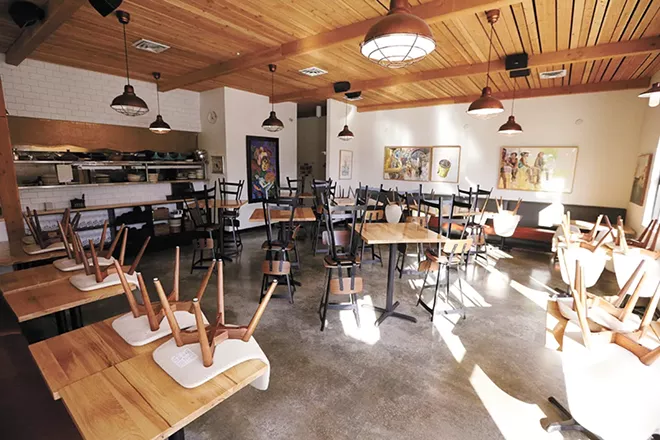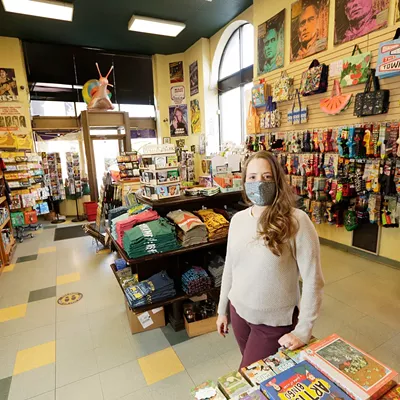
When Washington Gov. Jay Inslee announced on March 15 that he planned to drastically slow the spread of COVID-19 by temporarily closing restaurants and bars to anything but take-out, it was hard to imagine just how many people that could impact.
State economists were able to help shed some light on the scope of just how many people were instantly impacted statewide: tens of thousands in the Inland Northwest, and hundreds of thousands statewide, just in the hospitality and service industries.
That picture got even bleaker this week, as Inslee announced a stay-home order Monday night, March 23, to take effect on Wednesday.
"This is Washington's 'Stay Home, Stay Healthy' order," Inslee said in a broadcast to state residents. "We've been very clear on the need for everyone to stay home. And while most Washingtonians are doing their part, some still don't grasp the seriousness of this pandemic."
The order will close all nonessential businesses, excluding places like grocery stores, doctor's offices, child care, gas stations and pharmacies, among others. Restaurants can continue offering to-go orders, and businesses that are able to can have their employees work from home. Under the order, people are not allowed to leave their homes except for essential things like purchasing food or going to the doctor. All gatherings, from weddings and funerals to a small gathering at someone's home, are banned. However, going outside for a walk, bike ride or gardening is allowed, as long as people follow social distancing.
Under the initial March 15 order, affecting everything from restaurants and entertainment venues to hairdressers and nail salons, places like hotels and motels weren't required to close, but many started laying people off as events were canceled and tourism plummeted.
In Spokane, in the wake of the NCAA tournament and other large event cancellations, the Davenport hotels laid off hundreds of staffers and announced the temporary closure of four of five hotels.
Many restaurants switched to take-out if they could, but still laid off serving staff, while many bars shut down completely.
A total of 24,000 people work in motels, hotels, restaurants and bars in Spokane, which is lumped in with regional statistics for Stevens and Pend Oreille counties, says Doug Tweedy, an economist with the state Employment Security Department. Tweedy analyzes data for Ferry, Stevens, Pend Oreille, Lincoln, Whitman and Spokane counties.
Statewide, there are about 288,000 workers in those hospitality areas.
But that doesn't include the many retail workers impacted by this week's order. In Spokane, there are another 40,000 people who work in retail, of which about 5,000 work in grocery and beverage sales that will be able to remain open during the stay-home order.
Statewide, a total of about 391,000 work in retail, of which about 68,000 are in grocery and beverage sales.
"These are the storekeepers, so vehicle sales, parts dealers, furniture, garden supply, health and personal and general merchandise," Tweedy says.
Idaho's governor still had not ordered public gathering places to shutter as of Monday, but people were encouraged to distance themselves, and some cities including Coeur d'Alene and Post Falls opted to issue their own orders shuttering bars and restaurants except for to-go orders.
The wider picture of how many jobs will be impacted statewide and nationally is bleaker still, with everything from tourism to the arts collapsing with shelter-in-place orders coming out in many cities and states.
By June, Washington state could be looking at a permanent loss of nearly 120,000 jobs, according to an analysis by the Economic Policy Institute. The nonpartisan think tank points to forecasts by major banks, including Deutsche Bank and JPMorgan, with the middle-of-the-road projections between them predicting about 5.25 million jobs will be lost around the country by this summer.
It won't be clear until later this week just how many people had applied for unemployment due to the governor's March 15 order, in part because some people were expected to be using up sick leave first, and in part because those statistics take a little more than a week to be compiled for release. With the March 23 stay-home order, unemployment is likely to spike further still.
While application numbers still weren't in, the state's unemployment site had more than a half-million hits on Monday and Tuesday of last week alone, when a normal amount of traffic would be closer to 30,000 hits.
Forecasts were still in the works and ever-changing, but in looking at King County, which has been the hardest hit and took measures ahead of the east side of the state, you can get an idea of how things are going to look here, Tweedy says.
Looking at initial unemployment insurance claims, which are a leading indicator for the future, Tweedy says that King County had 1,500 claims for the last week of February, which jumped to 5,000 for the first week of March.
"That was still before some of the business shutdowns," Tweedy says. "That's a big jump."
The state will have more official projections for what we could expect later this week, as data for the first few weeks of March is compiled, he says. But already, we know that 2,000 of those claims in King County for the first week of March came from the food and beverage industry.
When asked if this could be similar to what we saw with the Great Recession in 2008, Tweedy says it's really very different.
"It's much different," Tweedy says. "It's a health event, so it's really hard to project, because we don't know what the spread of the virus will be. I couldn't even hazard a guess right now." ♦
























